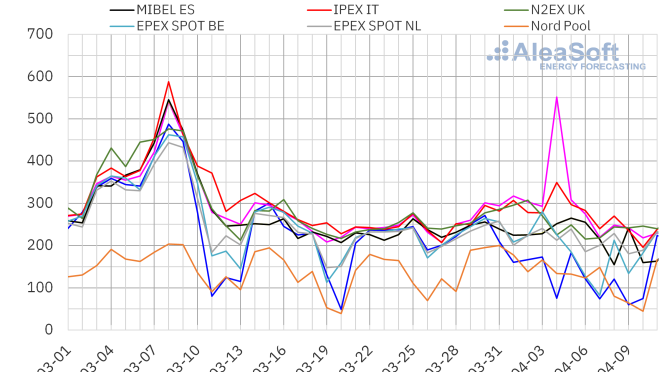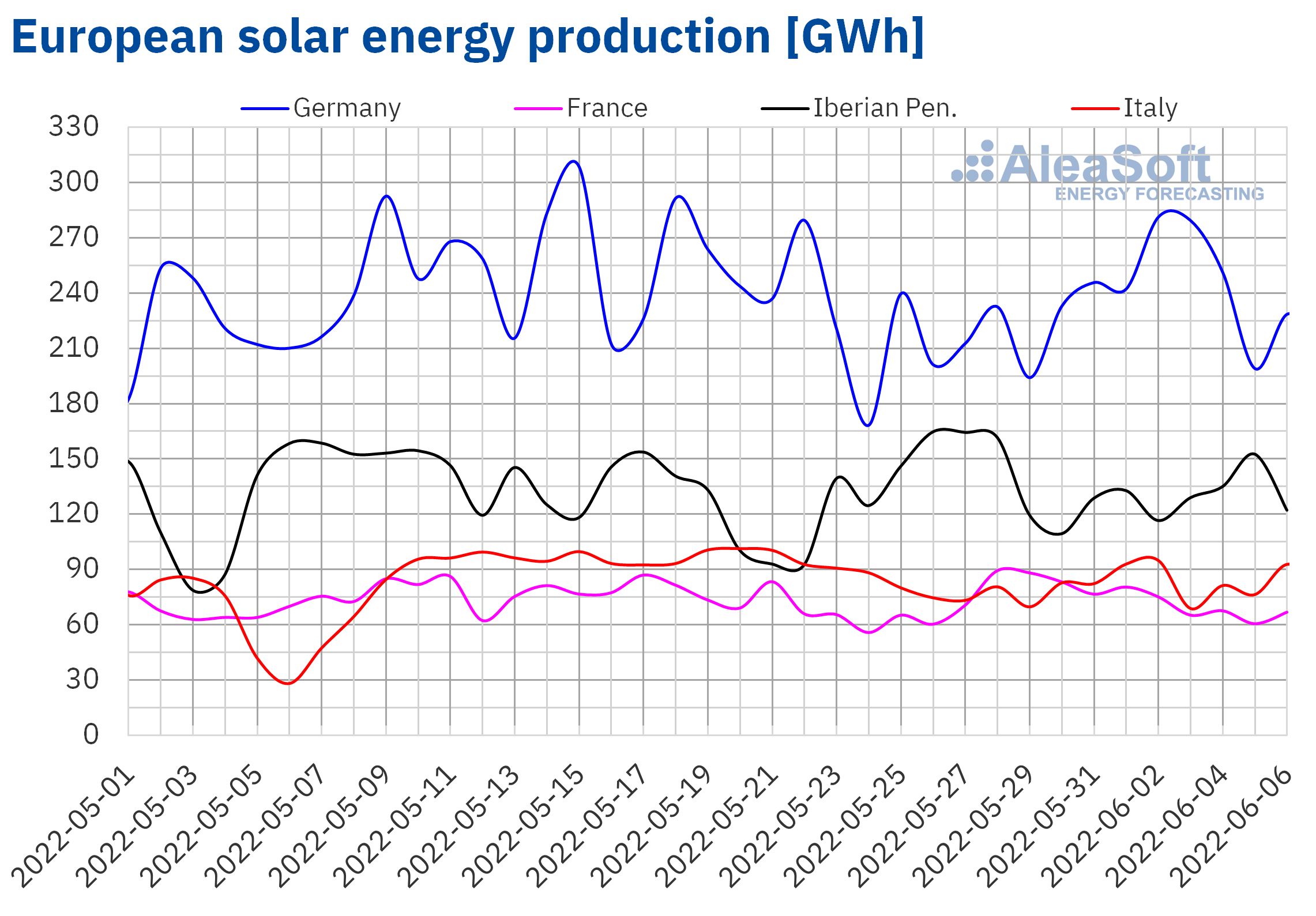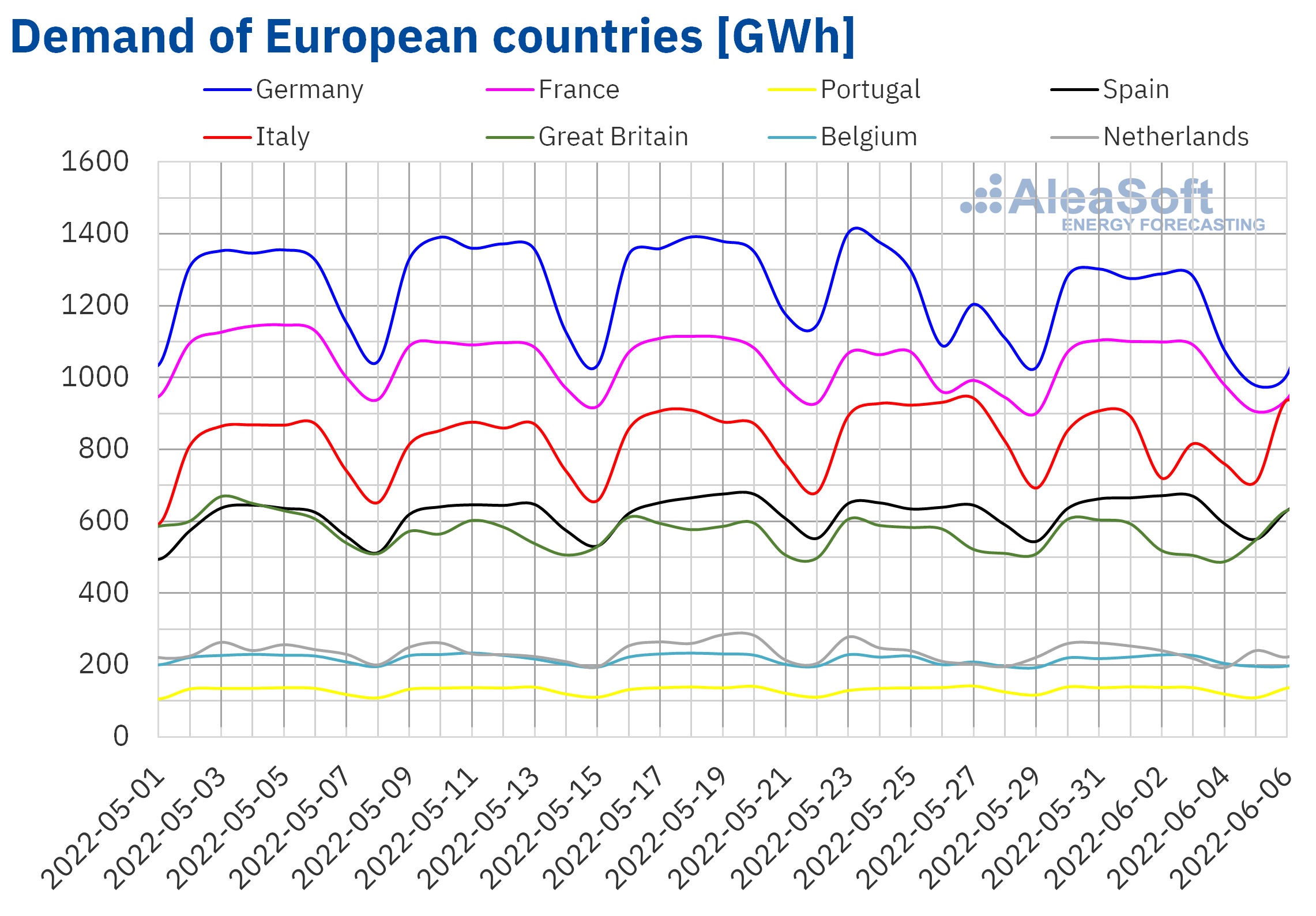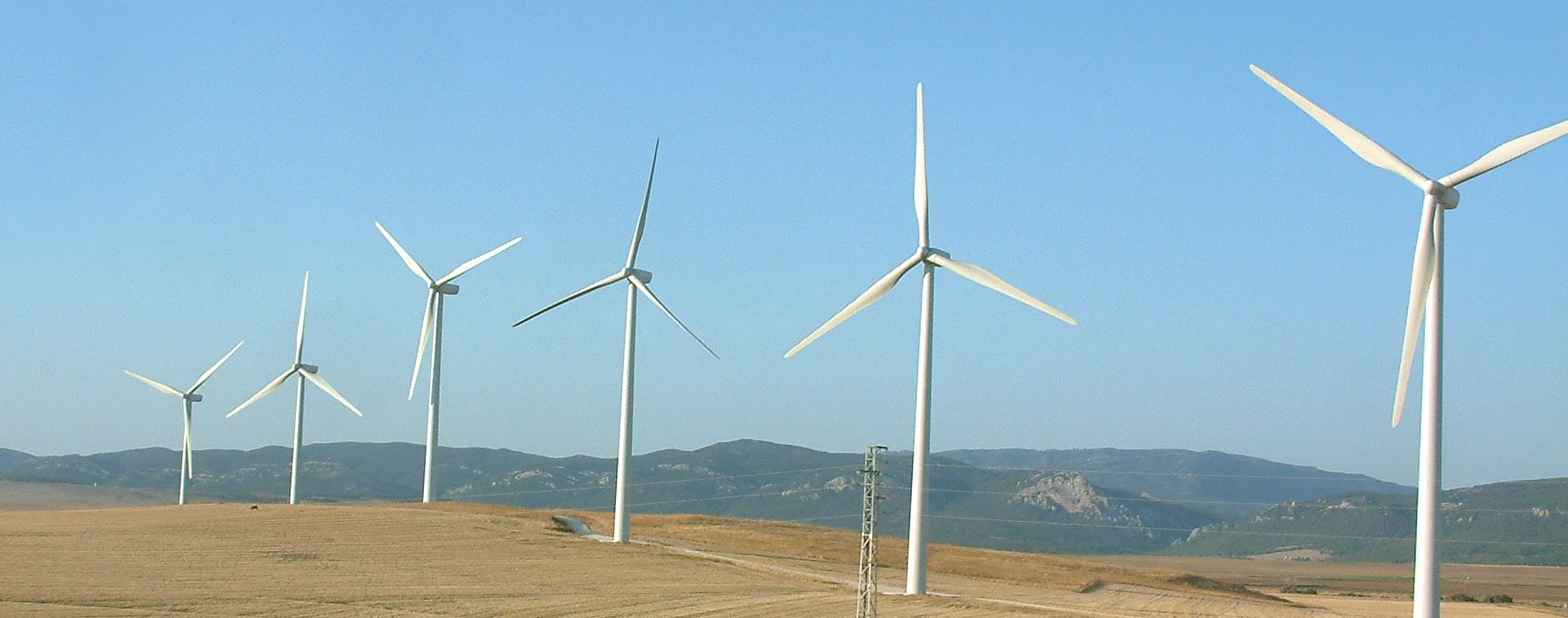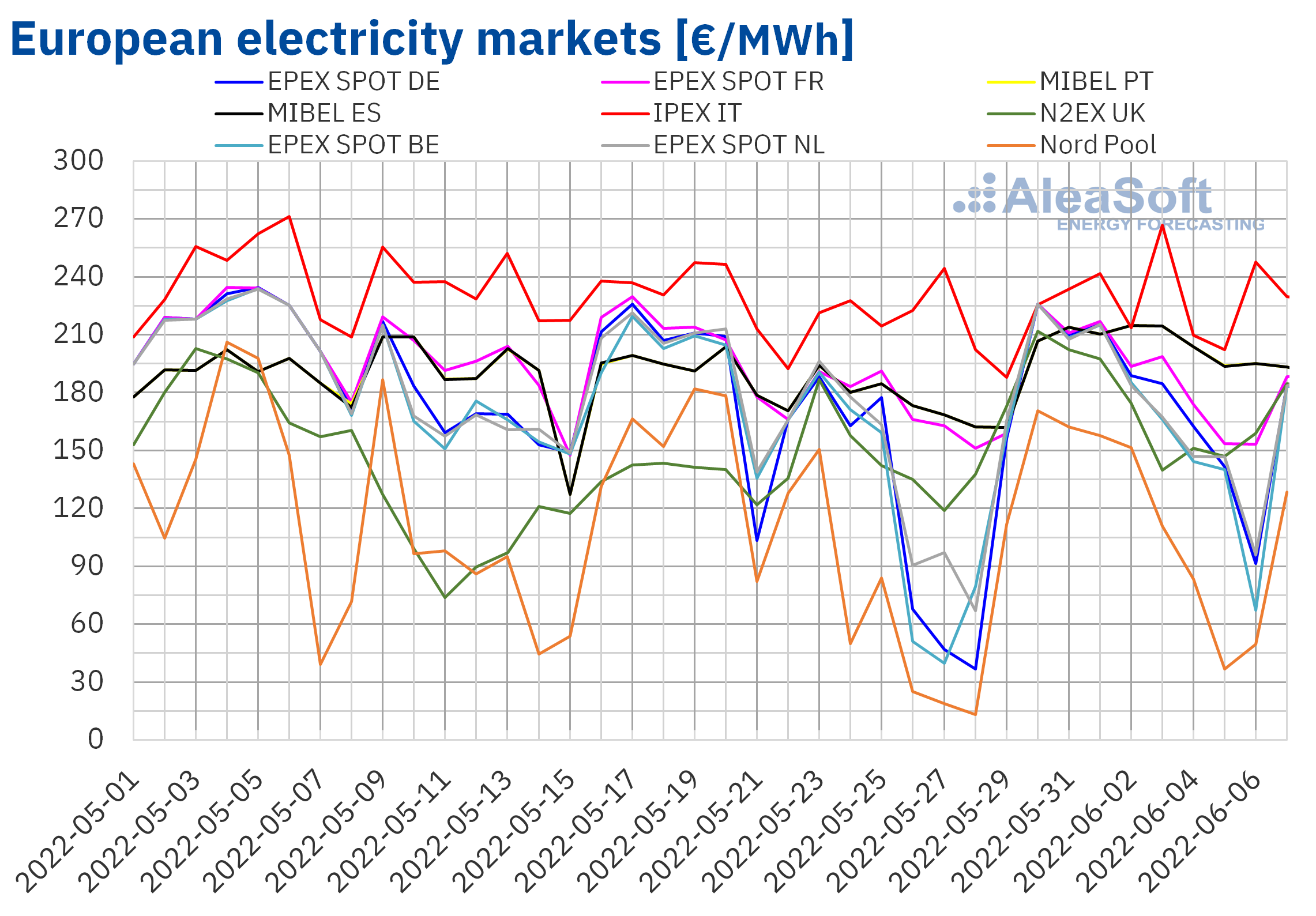In the first week of June, European electricity markets prices rose in a generalised way due to the fact that the wind energy production was lower than that of the previous week. In the Iberian market, lower solar energy production also helped prices rise. On average, gas, Brent and CO2 prices were higher than those of the last week of May. However, during the weekend and the beginning of the second week of the month, negative hourly prices were registered in some markets.
Photovoltaic and solar thermal energy production and wind energy production
During the week of May 30, the solar energy production increased by 18% in the German market compared to the previous week. In the Italian and French markets it also increased, by 4.0% and 2.8% respectively. On the contrary, in the Iberian Peninsula the solar energy production fell by 11%, due to the decrease of 18% in Portugal and 11% in Spain.
For the week of June 6, the AleaSoft Energy Forecasting’s forecasts indicate an increase in solar energy production in the German market, while it is expected to decrease in the Spanish and Italian markets.
Source: Prepared by AleaSoft Energy Forecasting using data from ENTSO-E, RTE, REN, REE and TERNA.
Source: Prepared by AleaSoft Energy Forecasting using data from ENTSO-E, RTE, REN, REE and TERNA.
The first week of June ended with a general reduction in wind energy production compared to the previous week, as expected at AleaSoft Energy Forecasting. The largest drop was registered in the German market, in which the production with this technology fell by 69%. In the rest of the analysed markets, the wind energy production fell between 40% and 55%.
For the week of June 6, the AleaSoft Energy Forecasting’s forecasts indicate a general increase in wind energy production.
Source: Prepared by AleaSoft Energy Forecasting using data from ENTSO-E, RTE, REN, REE and TERNA.
Electricity demand
In the week of May 30, the average temperatures were higher than those of the previous week in most European markets analysed at AleaSoft Energy Forecasting. The exceptions were the markets of Great Britain and the Netherlands where they were slightly lower.
The electricity demand behaved unevenly in the analysed European markets. In the markets of France, the Netherlands, Belgium and Spain, the demand increased, in the first three cases favoured by the fact that, in the previous week, on May 26, Ascension Day was celebrated in those countries. The increases were between 2.2% of Spain and 5.0% of France.
In the markets of Germany, Portugal, Great Britain and Italy, the demand fell. The decreases were between 0.3% registered in the German and Portuguese markets and 7.7% of the Italian market. June 2 was Republic Day in Italy, and in Great Britain, June 2 and 3 were holidays to celebrate the Platinum Jubilee of Elizabeth II, which helped drive down demand.
In the week of June 6, average temperatures are expected to increase in a generalised way. In the case of the demand, the AleaSoft Energy Forecasting’s forecasts point to it increasing in all markets except France, Germany and Belgium.
Source: Prepared by AleaSoft Energy Forecasting using data from ENTSO-E, RTE, REN, REE, TERNA, National Grid and ELIA.
European electricity markets
In the week of May 30, prices of all European electricity markets analysed at AleaSoft Energy Forecasting increased compared to the previous week. The largest price rise was that of the Nord Pool market of the Nordic countries, of 93%. On the other hand, the smallest increase, of 4.8%, was that of the IPEX market of Italy. In the rest of the markets, the price increases were between 14% of the EPEX SPOT market of France and 59% of the EPEX SPOT market of Germany.
In the first week of June, average prices were below €200/MWh in almost all analysed electricity markets. The exceptions were the Italian market with a weekly average of €227.60/MWh and the MIBEL market of Portugal and Spain, with €208.28/MWh and €208.24/MWh, respectively. On the other hand, the lowest weekly average, of €124.70/MWh, was registered in the Nord Pool market. In the rest of the markets, prices were between €174.82/MWh of the British market and €196.25/MWh of the French market.
Regarding hourly prices, despite the rise in weekly average prices, negative hourly prices were registered in several markets in the first days of June. In the Belgian market, there was one hour with a negative price on June 4 and eight hours on June 6. On June 6, there were also three hours with negative prices in the German market and six in the Dutch market. The lowest price, of ?€90.00/MWh, was reached on June 6 at 14:00 in the Belgian market and it was the lowest in this market since April 24.
During the week of May 30, the general decrease in wind energy production favoured price increases in the European electricity markets. In the Iberian Peninsula, the solar energy production also decreased, which contributed to MIBEL market prices exceeding €200/MWh. On the other hand, the average of gas and CO2 prices for the week exceeded that of the previous week, also helping to increase electricity markets prices.
On June 6 and 7, prices of most analysed electricity markets were up to 41% lower than the average of the working days of the previous week, except in Italy where they were 1.0% higher.
The AleaSoft Energy Forecasting’s price forecasting indicates that for the whole of the week of June 6, European electricity markets prices might decrease influenced by a significant increase in wind energy production.
Source: Prepared by AleaSoft Energy Forecasting using data from OMIE, EPEX SPOT, Nord Pool and GME.
Electricity futures
During the first week of June, between the sessions of May 27 and June 3, electricity futures prices for the fourth quarter of 2022 registered heterogeneous behaviours in the European markets analysed at AleaSoft Energy Forecasting. On the one hand, there are the EEX market of Germany and the United Kingdom and the ICE market of the United Kingdom, Belgium and the Netherlands, where prices registered decreases of between 2.4% and 5.5%. On the other hand, there are the EEX market of Spain and Italy and the OMIP market of Spain and Portugal, where significant increases of between 10% and 20% were observed. Finally, there are the markets where the variations were smaller in relation to the rest, the EEX market of France and the NASDAQ market of the Nordic countries, both with increases of 0.5%. Also in the Nordic region, but in the ICE market, the rise was slightly more notable, of 1.7%.
However, when analysing futures prices for next year, the behaviour is much more homogeneous, with a general rise in all analysed markets. The registered increases range from 1.5% registered in the EEX market of the United Kingdom, to 13% of the NASDAQ market of the Nordic countries. However, the highest absolute increase was that registered in the EEX market of Germany, with a rise of €16.38/MWh.
Brent, fuels and CO2
Settlement prices of Brent oil futures for the Front?Month in the ICE market, during the first week of June, remained above $115/bbl. The week began with price increases and on Tuesday, May 31, a settlement price of $122.84/bbl was reached. This price was 8.2% higher than that of the previous Tuesday and the highest since March 8. In contrast, the weekly minimum settlement price, of $116.29/bbl, was registered on Wednesday. But on Thursday prices resumed the upward trend. As a result, on Friday, June 3, a settlement price of $119.72/bbl was reached, 0.2% higher than that of the previous Friday. On Monday, June 6, the settlement price was slightly lower than that of the last session of the first week of June, registering a value of $119.51/bbl, which was 1.8% lower than that of the previous Monday, May 30.
In recent days, the recovery of the demand in China favoured the increase in prices. As the restrictions to control COVID?19 ease, demand is expected to continue to increase. On the other hand, on Thursday, June 2, OPEC+ agreed to greater production increases starting in July. However, there is concern about whether the member countries will be able to meet the production commitments made.
As for TTF gas futures in the ICE market for the Front?Month, they began the week of May 30 with price increases. On Tuesday, May 31, the maximum settlement price of the week, of €94.00/MWh, was reached. For the week as a whole, the average price increased by 1.4% compared to the previous week. But in the first days of June, prices began a downward trend. As a result, the settlement price of Monday, June 6, was €82.56/MWh. This price was 6.2% lower than that of the previous Monday and the lowest since February.
Regarding CO2 emission rights futures prices in the EEX market for the reference contract of December 2022, on Monday, May 30, they registered a settlement price of €83.97/t. This price was slightly lower than that of the last session of the previous week, but 7.4% higher than that of the previous Monday. As of Tuesday, prices began an upward trend. As a consequence, on Friday, June 3, the weekly maximum settlement price of €86.87/t was reached. This price was 3.2% higher than that of the previous Friday. For the week as a whole, prices increased by 4.3% compared to those of the previous week. However, on Monday, June 6, prices fell and the settlement price was €81.43/t, 3.0% lower than that of the last Monday of May. In the second week of June, the European Parliament will vote on various proposals for the reform of this market, which will exert its influence on the evolution of prices.
Source: Prepared by AleaSoft Energy Forecasting using data from ICE and EEX.
AleaSoft Energy Forecasting’s analysis on the prospects for energy markets in Europe and the renewable energy projects financing
This Thursday, June 9, a new edition of the AleaSoft Energy Forecasting’s monthly webinars will be held, which will once again have the participation of speakers from Engie Spain. The webinar will analyse the evolution of the European energy markets during the first half of 2022 and the prospects for the second half of the year. In addition, the current situation of the renewable energy projects financing and PPA will be explained, as well as the main novelties in the regulation of the Spanish electricity sector, topics in which Engie Spain will contribute its valuable experience.
For the renewable energy projects financing and PPA, it is necessary to be able to estimate the income of the plant with the help of long?term price curves forecasts with hourly granularity. These forecasts are also necessary for risk and hedging management, portfolio valuation and audits, and for monitoring a base load or fixed volume PPA, once signed, for example, to estimate whether the produced energy will be sufficient to cover the contract and how much acquiring that lack of energy in the market would cost.
